| Web
and Book design,
Copyright, Kellscraft Studio 1999-2018 (Return to Web Text-ures) |
 (HOME)
|
|
CHAPTER
V THE
ATTEMPT TO
REACH KING EDWARD VII
LAND Towards evening
we began to pass a
number of small floe-bergs and pack-ice. We could not see very far
ahead, as
the weather was thick, so we steered more to the west to skirt this
mass of
ice. One berg had evidently been overturned, and also showed signs of
having
been aground. The Adelie penguins had become much more numerous, and we
saw an
occasional seal, but too far off to distinguish the species. During the
early
hours of January 18 we passed a few large bergs, and as morning
progressed the
wind increased, ranging between south by west and . south by east. The
ship was
pitching to a short sea, and as the water coming on board froze on
deck, and in
the stables, we made shift to keep
it out by nailing
canvas over the gaping holes in the bulwarks. Adams and Mackay were
engaged in
this very chilly job; Adams, slung in a rope over the side, every now
and then
got soaked up to the middle when the ship dipped into the sea, and as
the
temperature of the air was four degrees below freezing-point, his
tennis
trousers were not of much value for warmth in the circumstances. When
he got
too cold to continue outside, Mackay took his place, and between them
they made
a very creditable jury bulwark, which prevented the bulk of the water
rushing
into the stable. The wind continued with a force of about forty miles
an hour,
up till midday of the 19th, when it began to take off a little, and the
sky
broke blue to the northeast; the decks were thickly coated with soft
ice, and
the freshwater-pumps had frozen up hard. We were now
revelling in the
indescribable freshness of the Antarctic that seems to permeate one's
being,
and which must be responsible for that longing to go again which
assails each
returned explorer from polar regions. Our position at noon on January
19 was
latitude 73° 44' South and longitude 177° 19' East. The wind had
decreased
somewhat by midnight, and though the air remained thick and the sky
overcast
during the whole of the 20th, the weather was better. We passed through
occasional masses of floating ice and large tabular bergs, and at noon
were in
latitude 74° 45' South, longitude 179° 21' East.
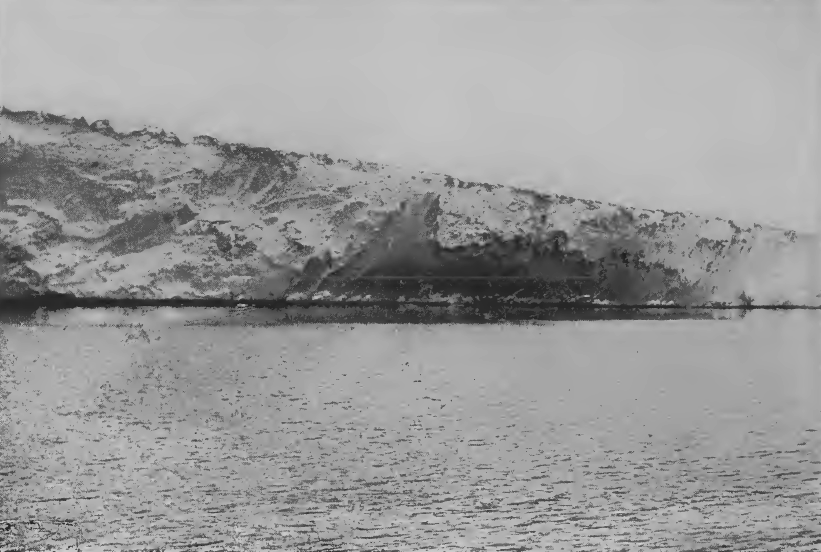 VIEW OF THE GREAT ICE BARRIER On
the 21st the weather grew
clear,
the temperature was somewhat higher, and the wind light. We observed
small flights
of snow petrels and Antarctic petrels, and saw a single giant petrel
for the
first time. There were also several whales spouting in the distance.
The same
sort of weather continued throughout the day, and similar weather,
though
somewhat clearer, was experienced on the 22nd. On the morning of the
23rd we
saw some very large icebergs, and towards evening these increased in
number.
They were evidently great masses broken off the Barrier. Early in the
morning
we passed a large tilted berg, yellow with diatoms. On our port side
appeared a
very heavy pack, in which a number of large bergs were embedded. Our
course for
these three days was about due south, and we were making good headway
under
steam. We were now
keeping a sharp look-out
for the Barrier, which we expected to see at any moment. A light
south-easterly
wind blew cold, warning us that we could not be very far away from the
ice-sheet. The thermometer registered some twelve degrees of frost, but
we
hardly felt the cold, for the wind was so dry. At 9.30 A.M. on
the 23rd a low
straight line appeared ahead of the ship. It was the Barrier. After
half an
hour it disappeared from view, having evidently been only raised into
sight as
an effect of mirage, but by eleven o'clock the straight line stretching
out
east and west was in full view, and we rapidly approached it. I had
hoped to
make the Barrier about the position of what we call the Western Bight,
and at
noon we could see a point on our starboard, from which the Barrier
dropped
back. This was evidently the eastern limit of the Western Bight.
Shortly after
noon we were within a quarter of a mile of the ice-face, and
exclamations of
wonder and astonishment at the stupendous bulk of the Barrier were
drawn from
the men who had not seen it before. We slowly
steamed along, noting the
various structures of the ice, and were thankful that the weather
promised to
keep fine, for the inlet to which we were bound could not easily have
been
picked up in thick weather. The height of the Barrier about this point
ranged
from a hundred and fifty feet to two hundred feet. In the afternoon,
about
half-past one, we passed an opening in the Barrier trending in a
south-easterly
direction, but its depth was only about three-quarters of a mile. The
eastern
point had the form of the bows of a gigantic man-of-war, and reached a
height
of about two hundred and thirty feet. It was appropriately called "The
Dreadnought." As we steamed
close in to the
Barrier, watching carefully for any sign of an opening, we were able to
observe
accurately the various changes in the ice-face. In places the wall was
perfectly smooth, clean cut from the top to the water-line, in other
places it
showed signs of vertical cracks, and sometimes deep caverns appeared,
which,
illuminated by the reflected light, merged from light translucent blue
into the
deepest sapphire. At times great black patches appeared on the sides of
the
Barrier in the distance, but as we neared them they were resolved into
huge
caverns, some of which cut the water-line. One was so large that it
would have
been possible to have steamed the Nimrod
through its entrance without touching either side or its top by mast or
yard.
Looking at the Barrier from some little distance, one would imagine it
to be a
perfectly even wall of ice; when steaming along parallel with it,
however, the
impression it gave was that of a series of points, each of which looked
as
though it might be the horn of a bay. Then when the ship came abeam of
it, one
would see that the wall only receded for a. few hundred yards, and then
new
points came into view as the ship moved on. In some places a cornice of
snow
overhung the Barrier top, and again in others the vertical cracks had
widened
so that some portions of the ice-wall seemed in immediate danger of
falling.
The vagaries of light and shadow made appearances very deceptive. One
inlet we
passed had the sides thrown up in little hummocks, not more than ten or
fifteen
feet high, but until we were fairly close these irregularities had the
appearance of hills. The weather
continued fine and calm.
During the voyage of the Discovery
we
had always encountered a strong westerly current along the Barrier, but
there
was absolutely no sign of this here, and the ship was making a good
five knots.
To the northward of us lay a very heavy pack, interspersed with large
ice-bergs, one of which was over two miles long and one hundred and
fifty feet
high. This pack-ice was much heavier and more rugged than any we had
encountered on the previous expedition. Evidently there must have been
an
enormous b Baking away of ice to the eastward for as far as we could
see from
the crow's-nest, to the north and east, this ice continued About midnight
we suddenly came to
the end of a very high portion of the Barrier, and found as we followed
round
that we were entering a wide shallow bay. This must have been the inlet
where
Borchgrevink landed in 1900, but it had greatly changed since that
time. He
describes the bay as being a fairly narrow inlet. On our way east in
the Discovery in 1902 we passed an
inlet
somewhat similar, but we did not see the western end as it was obscured
by fog
at the time. There seemed to be no doubt that the Barrier had broken
away at
the entrance of this bay or inlet, and so had made it much wider and
less deep
than it was in previous years. About half a mile down the bay we
reached fast
ice. It was now about half-past twelve at night, and the southerly sun
shone in
our faces. Our astonishment was great to see beyond the six or seven
miles of
flat bay ice, which was about five or six feet thick, high rounded
ice-cliffs,
with valleys between, running in an almost east and west direction.
About four
miles to the south we saw the opening of a large valley, but could not
say
where it led. Due south of us, and rising to a height of approximately
eight
hundred feet, were steep and rounded cliffs, and behind them sharp
peaks. The
southerly sun being low, these heights threw shadows which, for some
time, had
the appearance of bare rocks. Two dark patches in the face of one of
the further
cliffs had also this appearance, but a careful observation taken with a
telescope showed them to be caverns. To the east rose a long snow slope
which
cut the horizon at the height of about three hundred feet. It had every
appearance of ice-covered land, but we could not stop then to make
certain, for
the heavy ice and bergs lying to the northward of us were setting down
into the
bay, and I saw that, if we were not to be beset, it would be necessary
to get
away at once. All round us were numbers of great whales showing their
dorsal
fins as they occasionally sounded, and on the edge of the bay-ice half
a dozen
Emperor penguins stood lazily observing us. We named this place the Bay
of
Whales, for it was a veritable playground for these monsters. We tried to
work to the eastward
so-as once more to get close to the Barrier which we could see rising
over the
top of the small bergs and pack-ice, but we found this impossible, and
so
struck northwards through an open lead and came south to the Barrier
again about
2 A.M. on the 24th. We coasted eastward along the wall of ice, always
on the
look-out for the inlet. The lashings had been taken off the motor-car,
and the
tackle rigged to hoist it out directly we got alongside the ice-foot,
to which
the Discovery had been moored; for
in
Barrier Inlet we proposed to place our winter quarters. I must leave
the narrative for a
moment at this point and refer to the reasons that made me decide on
this inlet
as the site for the winter quarters. I knew that Barrier Inlet was
practically
the beginning of King Edward VII Land, and that the actual bare land
was within
an easy sledge journey of that place, and it had the great advantage of
being
some ninety miles nearer to the South Pole than any other spot that
could be
reached with the ship. A further point of importance was that it would
be an
easy matter for the ship on its return to us to reach this part of the
Barrier,
whereas King Edward VII Land itself might quite conceivably be
unattainable if
the season was adverse. Some of my Discovery
comrades had also considered Barrier Inlet a good place at which to
winter.
After thinking carefully over the matter I had decided in favour of
wintering
on the Barrier instead of on actual land, and on the lroanya's
departure I had
sent a message to the headquarters of the expedition in London to the
effect
that, in the event of the Nimrod
not
returning at the usual time in 1908, no steps were to be taken to
provide a
relief ship to search for her in 1909, for it was only likely under
those circumstances
that she was frozen in; but that if she did not turn up with us in
1909, then
the relief expedition should start in December of that year. The point
to which
they should first direct their search was to be Barrier Inlet, and if
we were
not found there, they were to search the coast of Bing Edward VII Land.
I had
added that it would only be by stress of the most unexpected
circumstances that
the ship would be unable to return to New Zealand. However, the
best-laid schemes often
prove impracticable in polar exploration, and within a few hours our
first plan
was found impossible of fulfilment. Within thirty-six hours a second
arrangement had to be abandoned. We were steaming along westward close
to the
Barrier, and according to the chart we were due to be abreast of the
inlet
about 6 A.M., but not a sign was there of the opening. We had passed
Borchgrevink's Bight at 1 A.M., and at 8 P.M. were well past the place
where
Barrier Inlet ought to have been. The Inlet had disappeared, owing to
miles of the
Barrier having calved away, leaving a long wide bay joining up with
Borchgrevink's Inlet, and the whole was now merged into what we had
called the
Bay of Whales. This was a great disappointment to us, but we were
thankful that
the Barrier had broken away before we had made our camp on it. It was
bad
enough to try and make for a port that had been wiped off the face of
the
earth, when all the intending inhabitants were safe on board the ship,
but it
would have been infinitely worse if we had landed there whilst the
place was
still in existence, and that when the ship returned to take us off she
should
find the place gone. The thought of what might have been made me decide
then
and there that, under no circumstances, would I winter on the Barrier,
and that
wherever we did land we would secure a solid rock foundation for our
winter
home. We had two
strings to our bow, and I
decided to use the second at once and push forward towards King Edward
VII
Land. Just after 8 A.M. on the 24th we turned a corner in the Barrier,
where it
receded about half a mile, before continuing to the eastward again. The
line of
its coast here made a right angle, and the ice sloped down to sea-level
at the
apex of the angle, but the elope was too steep and too heavily
crevassed for us
to climb up and look over the surface if we had made a landing. We tied the
ship up to a fairly
large floe, and I went down to England's cabin to talk the matter over.
In the
corner where we were lying there were comparatively few pieces of
floe-ice, but
outside us lay a very heavy pack, in which several large bergs were
locked. Our
only chance was to go straight on, keeping close to the Barrier, as a
lane of
open water was left between the Barrier and the edge of the pack to the
north
of us. Sights were taken for longitude by four separate observers, and
the
positions calculated showed us we were not only well to the eastward of
the
place where Barrier Inlet was shown on the chart, but also that the
Barrier had
receded at this particular point since January 1902. About nine
o'clock we cast off from
the floe and headed the ship to the eastward, again keeping a few
hundred yards
off the Barrier, for just here the cliff overhung, and if a fall of ice
had
occurred while we were close in the results would certainly have been
disastrous for us. I soon saw that we would not be able to make much
easting in
this way, for the Barrier was now trending well to the north-east, and
right
ahead of us lay an impenetrably close pack, set with huge icebergs. By
10 A.M..
we were close to the pack and found that it was pressed bard against
the
Barrier edge, and, what was worse, the whole of the northern pack and
bergs at
this spot were drifting in towards the Barrier. The seriousness of this
situation can be well realised by the reader if he imagines for a
moment that
he is in a small boat right under the vertical white cliffs of Dover;
that
detached cliffs are moving in from seaward slowly but surely, with
stupendous
force and resistless power, and that it will only be a question of
perhaps an
hour or two before the two masses come into contact with his tiny craft
between. 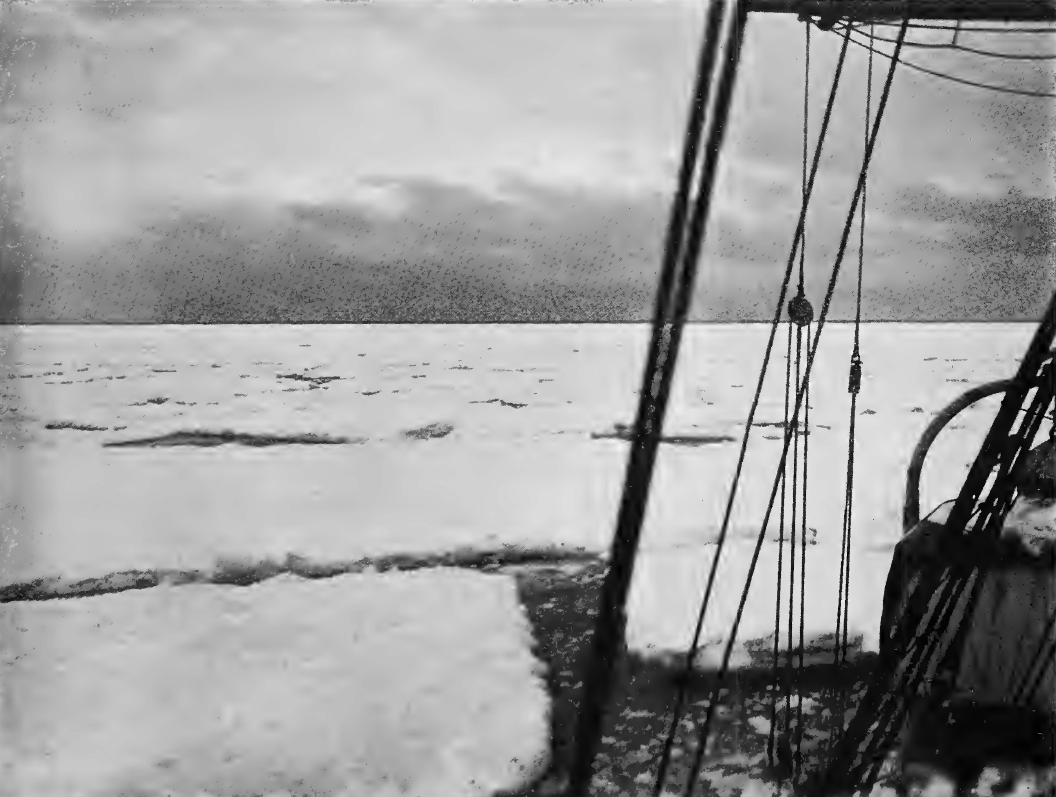 PUSHING THROUGH HEAVY FLOES IN THE ROSS SEA, THE DARK LINE ON THE HORIZON IS A "WATER SKY," AND INDICATES THE EXISTENCE OF OPEN SEA There
was nothing for it but
to
retrace our way and try some other route. Our position was latitude 78°
20'
South and longitude 162° 14' West when the ship turned. The pack had
already
moved inside the point of the cliff where we had lain in open water at
eight
o'clock, but by steaming hard and working in and out of the looser
floes we
just managed to pass the point at 11.20 A.M. with barely fifty yards of
open
water to spare between the Barrier and the pack. I breathed more
freely when we
passed this zone of immediate danger, for there were two or three
hundred yards
of clear water now between us and the pack. We were right under the
Barrier
cliff, which was here over two hundred and fifty feet high, and our
course lay
well to the south of west, being roughly southwest true; so as we moved
south
more quickly than the advancing ice we were able to keep close along
the
Barrier, which gradually became lower, until about three o'clock we
were
abreast of some tilted bergs at the eastern entrance of the Bay of
Whales.
There was a peculiar light which rendered distances and the forms of
objects
very deceptive, and a great deal of mirage, which made things appear
much
higher than they actually were. This was particularly noticeable in the
case of
the pack-ice; the whole northern and western sea seemed crowded with
huge
icebergs, though in reality there was only heavy pack. The penguins
that we had
seen the previous night were still at the same place, and when a couple
of
miles away from us they loomed up as if they were about six feet high.
This bay
ice, on which many seals were lying, was cracking, and would soon float
away,
with one or two large icebergs embedded in it. 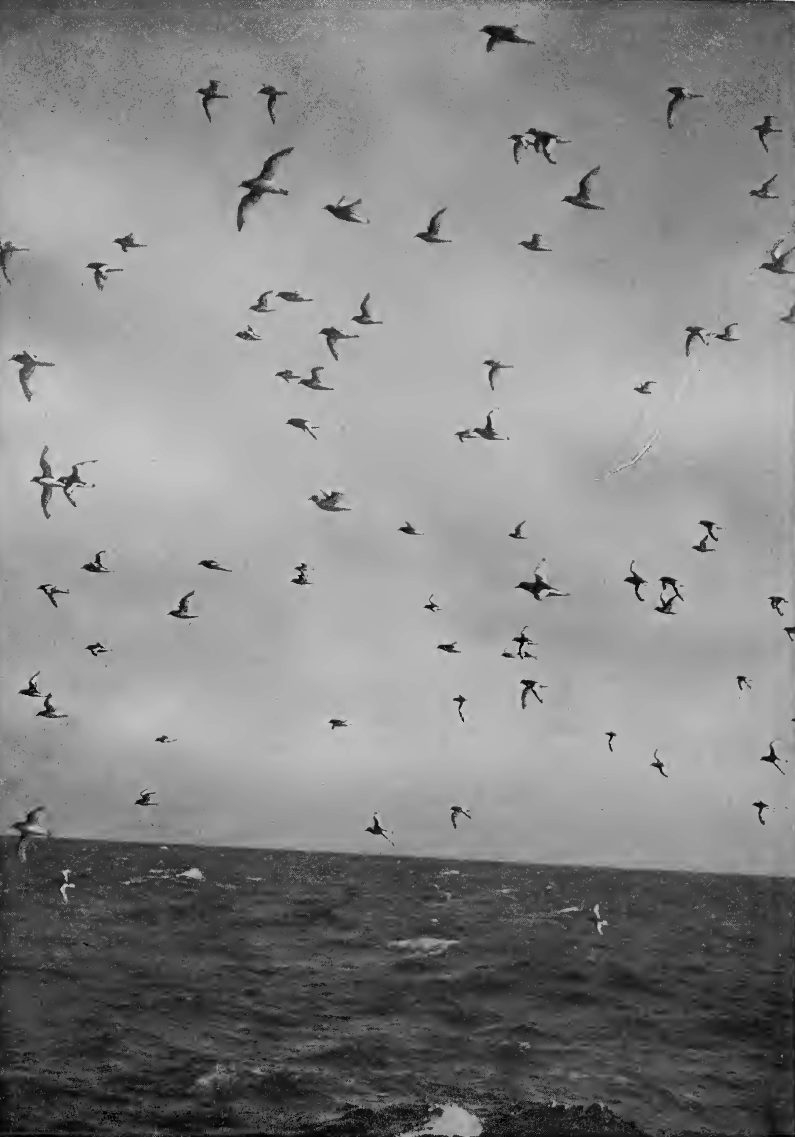 FLIGHT OF ANTARCTIC PETRELS When I came up
again, just before
noon on January 25, I found that my hopes for a clear run were vain.
Our noon
observations showed that we were well to the north of the Barrier, and
still to
the westward of the point we had reached the previous morning before we
had
been forced to turn round. The prospect of reaching King Edward VII
Land seemed
to grow more remote every ensuing hour. There was high hummocky pack
interspersed with giant icebergs to the east and south of the ship, and
it was
obvious that the whole sea between Cape Colbeck and the Barrier at our
present
longitude must be full of ice. To the northward the strong ice blink on
the
horizon told the same tale. It seemed as if it would be impossible to
reach the
land, and the shortness of coal, the leaky condition of the ship, and
the
absolute necessity of landing all our stores and putting up the hut
before the
vessel left us made the situation an extremely anxious one for me. I
had not
expected to find Barrier Inlet gone, and, at the same time, the way to
King
Edward VII Land absolutely blocked by ice, though the latter condition
was not
unusual, for every expedition in this longitude up till 1901 had been
held up
by the pack; indeed Ross, in this locality, sailed for hundreds of
miles to the
northward along the edge of a similar pack on this meridian. It is true
that we
had steam, but the Discovery, or
even
the Yermak, the most powerful ice-breaker ever built, would have made
no
impression upon the cemented field of ice. I decided to
continue to try and
make a way to the east for at least another twenty-four hours. We
altered the
course to the north, skirting the ice as closely as possible, and
taking
advantage of the slightest trend to the eastward, at times running into
narrow
cols-de-sac in the main pack, only to find it necessary to retrace our
way
again. The wind began to freshen from the west, and the weather to
thicken. A
little choppy sea washed over the edges of the floes, and the glass was
falling. About five o'clock some heavy squalls of snow came down, and
we had to
go dead slow, for the horizon was limited at times to a radius of less
than one
hundred yards. Between the squalls it was fairly clear, and we could
make out
great numbers of long, low bergs, one of which was over five miles in
length,
though not more than forty feet high. The waves were splashing up
against the
narrow end as we passed within a couple of cables' length of the berg,
and
almost immediately afterwards another squall swept down upon us. The
weather
cleared again shortly, and we saw the western pack moving rapidly
towards us
under the influence of the wind; in some places it had already met the
main
pack. As it was most likely that we would be caught in this great mass
of ice,
and that days, or even weeks, might elapse before we could extricate
ourselves,
I reluctantly gave orders to turn the ship and make full speed out of
this dangerous
situation. I could see nothing for it except to steer for McMurdo
Sound, and
there make our winter quarters. For many reasons I would have preferred
landing
at King Edward VII Land, as that region was absolutely unknown. A
fleeting
glimpse of bare cocks and high snow slopes was all that we obtained of
it on
the Discovery expedition, and had
we
been able to establish our winter quarters there, we could have added
greatly
to the knowledge of the geography of that region. There would perhaps
have been
more difficulty in the attempt to reach the South Pole from that base,
but I
did not expect that the route from there to the Barrier surface, from
which we
could make a fair start for the Pole, would have been impracticable. I
did not
give up the destined base of our expedition without a strenuous
struggle, as
the track of the ship given in the sketch-map shows; but the forces of
these
uncontrollable ice-packs are stronger than human resolution, and a
change of
plan was forced upon us. After more
trouble with the ice we
worked into clearer water and the course was set for McMurdo Sound,
where we
arrived on January 29, and found that some twenty miles of frozen sea
separated
us from Hut Point. I decided to lie off the ice-foot for a few days at
least,
and give Nature a chance to do what we could not do with the ship, that
is, to
break up the miles of ice intervening between us and our goal. So far the
voyage had been without
accident to any of the staff, but on the morning of the 31st, when all
hands
were employed getting stores out of the after hatch, preparatory to
landing
them, a hook on the tackle slipped and, swinging suddenly across the
deck,
struck Mackintosh in the right eye. He fell on the deck in great pain,
but was
able, in a few minutes, to walk with help to England's cabin, where
Marshall
examined him. It was apparent that the sight of the eye was completely
destroyed, so he was put under chloroform, and Marshall removed the
eye, being
assisted at the operation by the other two doctors, Michell and Mackay.
It was
a great comfort to me to know that the expedition had the services of
thoroughly good surgeons. Mackintosh felt the loss of his eye keenly;
not so
much because the sight was gone, but because it meant that he could not
remain
with us in the Antarctic. He begged to be allowed to stay, but when
Marshall
explained that he might lose the sight of the other eye, unless great
care were
taken, he accepted his ill-fortune without further demur, and thus the
expedition lost, for a time, one of its most valuable members. 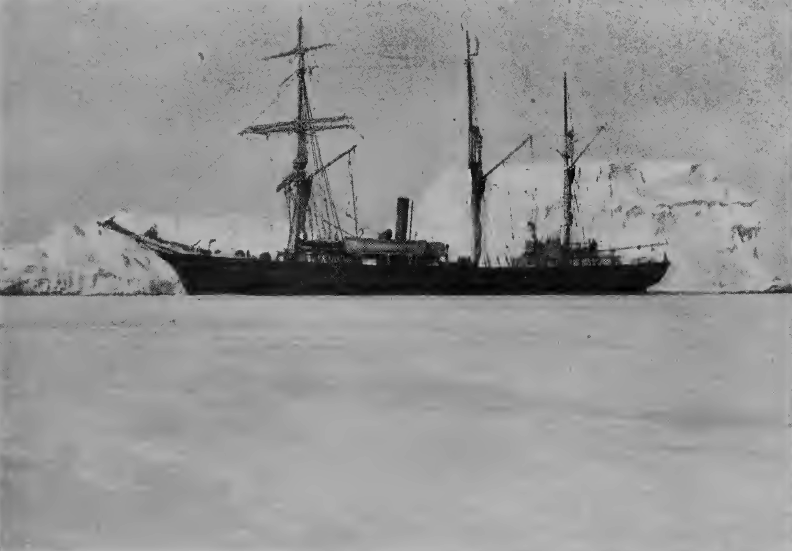 "NIMROD" MOORED OFF TABULAR BERGS Whilst waiting
at the ice, I thought
it as well that a small party should proceed to Hut Point, and report
on the
condition of the hut left there by the Discovery
expedition in 1904. I decided to send Adams, Joyce, and Wild, giving
Adams
instructions to get into the hut and then return the next day to the
ship. They
started off on their sixteen-mile march with plenty of provisions in
case of
being delayed, and a couple of spades. On their return, Adams reported
that
they had found the hut practically clear of snow, and the structure
quite
intact. On February 3 I
decided to wait no
longer at the ice face, but to seek for winter quarters on the east
coast of
Ross Island. About four o'clock we got under way and started towards
Cape Barne
on the look-out for a suitable landing-place. Steaming slowly north
along the
coast we saw across the bay a long, low snow slope, connected with the
bare
rock of Cape Royds, which appeared to be a likely place for winter
quarters. About eight
o'clock I left the ship
in a boat, accompanied by Adams and Wild. Proceeding towards the shore,
we used
the hand-lead at frequent intervals until we came up against fast ice.
This
covered the whole of the small bay from the corner of Flagstaff Point
(as we
afterwards named the seaward cliff at the southern end of Cape Royds)
to Cape
Barne to the southward. Close up to the Point the ice had broken out,
leaving a
little natural dock into wmeh we ran the boat. Adams and I scrambled
ashore,
crossing a well-defined tide-crack and going up a smooth snow-slope,
about
fifteen yards wide, at the top of which was bare rock. Hundreds of
Adelie
penguins were moving to and fro on the top of the slope, and they
greeted us
with hoarse squawks of excitement. A very brief
examination of the
vicinity of the ice-foot was sufficient to show us that Cape Royds
would be an
excellent place at which to land our stores. We therefore shoved off
again, and
skirting along the ice-foot to the south, sounded the bay and found
that the
water deepened from two fathoms close in shore to about twenty fathoms
four
hundred yards further south. After
completing these soundings we
pulled out towards the ship, which had been coming in very slowly. We
were
pulling along at a good rate when suddenly a heavy body shot out of the
water,
struck the seaman who was pulling stroke, and dropped with a thud into
the
bottom of the boat. The arrival was an Adelie penguin. It was hard to
say who
was the most astonished —
the penguin,
at the result of its leap on to what it had doubtless thought was a
rock, or
we, who so suddenly took on board this curious passenger. The sailors
in the
boat looked upon this incident as an omen of good luck. There is a
tradition
amongst seamen that the souls of old sailors, after death, occupy the
bodies of
penguins, as well as of albatrosses; this idea, however, does not
prevent the
mariners from making a hearty meal off the breasts of the former when
opportunity offers. We arrived on board at 9 P.M., and by 10 P.M. on
February 3
the Nimrod was moored to the bay
ice,
ready to land the stores. Immediately
after securing the ship
I went ashore, accompanied by the Professor, England, and Dunlop, to
choose a
place for building the hut. We passed the penguins, which were marching
solemnly to and fro, and on reaching the level land, made for a huge
boulder of
kenyte, the most conspicuous mark in the locality. I thought that we
might
build the hut under the lee of this boulder, sheltered from the
south-east wind,
but the situation had its drawbacks, as it would have entailed a large
amount
of levelling before the foundation of the hut could have been laid. We
crossed
a narrow ridge of rock just beyond the great boulder, and, turning a
little to
the right up a small valley, found an ideal spot for our winter
quarters.' The
floor of this valley was practically level and covered with a couple of
feet of
volcanic earth; at the sides the bed-rock was exposed, but a rough eye
measurement was quite sufficient to show that there would be not only
ample
room for the hut itself, but also for all the stores, and for a stable
for the
ponies. A hill right behind this little valley would serve as an
excellent
shelter to the hut from what we knew was the prevailing strong wind,
that is,
the south-easter. A glance at the illustrations will give the reader a
much
better idea of this place than will a written description, and he will
see how
admirably Nature had provided us with a protection against her own
destructive
forces. A number of seals lying on the bay ice gave promise that there
would be
no lack of fresh meat. 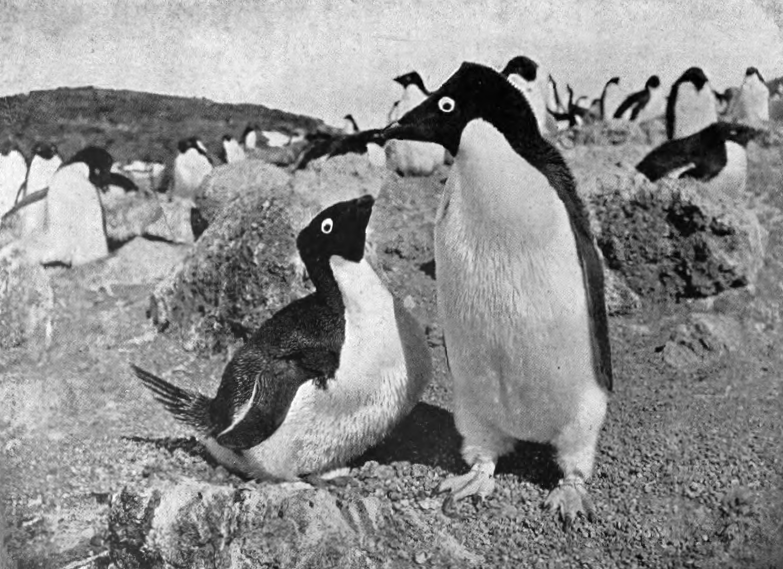 ADELIE PENGUINS AT CAPE ROYDS 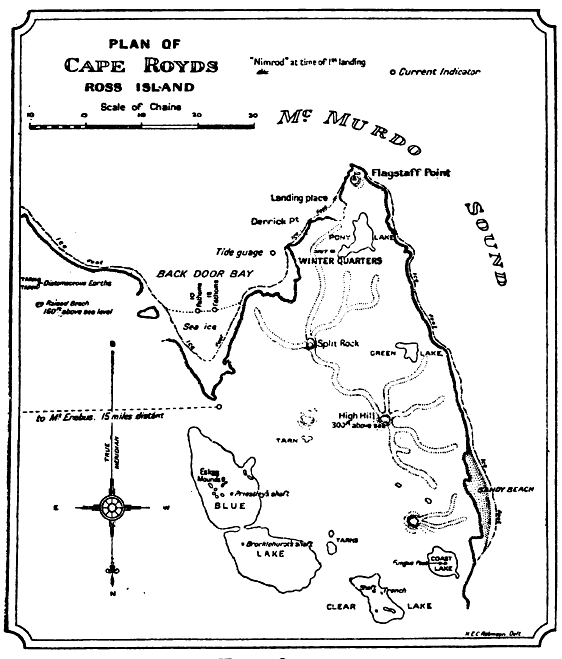 WINTER QUARTERS With this ideal
situation for a
camp, and everything else satisfactory, including a supply of water
from a lake
right in front of our little valley, I decided that we could not do
better than
start getting our gear ashore at once. There was only one point that
gave me
any anxiety, and that was as to whether the sea would freeze over
between this
place and Hut Point in ample time for us to get across for the southern
and
western journeys in the following spring. It was also obvious that
nothing
could be done in the way of laying out depots for the next season's
work, as
directly the ship left we would be cut off from any communication with
the
lands to the south of us, by sea and by land, for the heavily crevassed
glaciers fringing the coast were an effectual bar to a march with
sledges.
However, time was pressing, and we were fortunate to get winter
quarters as
near as this to our starting-point for the south. 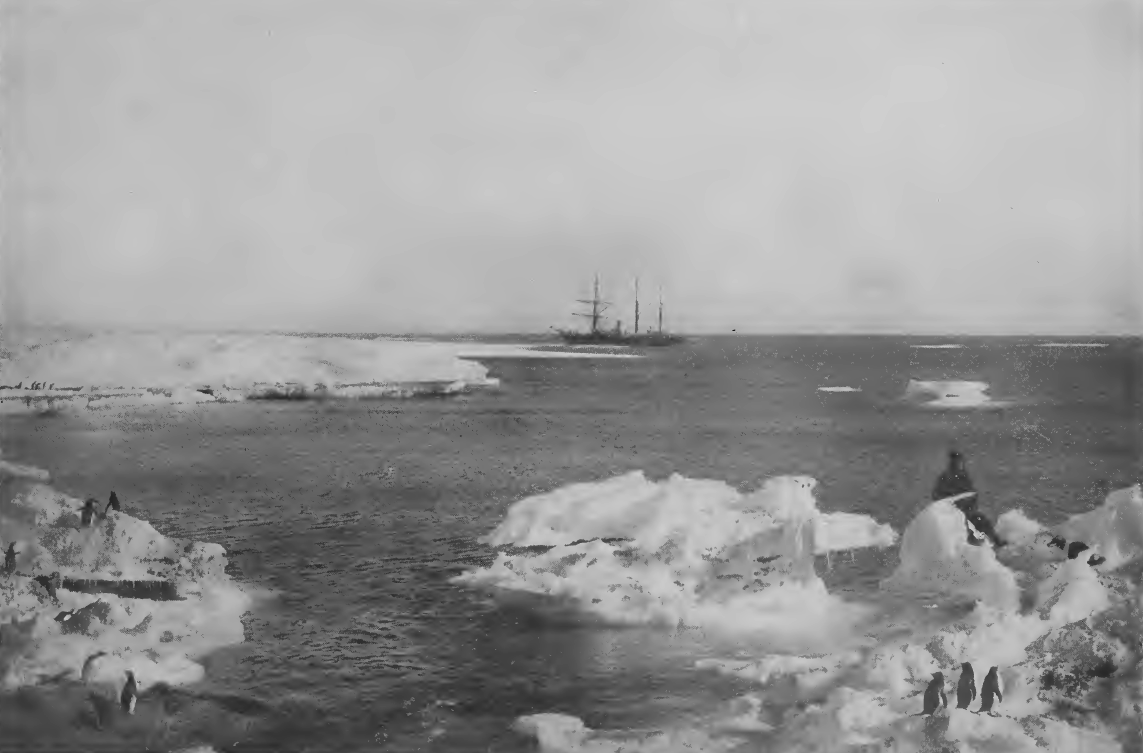 THE "NIMROD" LYING OFF THE PENGUIN ROOKERY, CAPE ROYDS
|